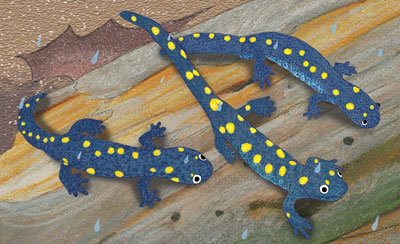
Spotted Salamanders
One amazing animal to get to know better is the salamander! Salamanders are amphibians that have long, slender bodies that are moist and smooth. Salamanders in the world vary greatly from color to size. Some have 2 or 4 legs and others have lungs or gills, or neither and breath through their skin. Others have identifiable spots that are easily seen in the night thanks to their yellow florescent spots along their backs. These spots are mostly identified with the Spotted salamander. Our book Salamander Season chronicles the journey of a colony of Spotted salamanders in the process of breeding within a vernal pool (a temporary pool of water).

Salamander egg and tadpole
For most species of salamanders, humid forests and a water source is crucial for their survival to produce offspring and to keep their skin moist. Salamanders are bred hundreds at a time and are born as tadpoles from their eggs. Over time, their bodies develop and the process of breeding in a vernal pool starts all over again.
Salamanders are generally nocturnal and keep cool during the day under rocks or trees. During the night, they go hunting for food which primarily consists of meat such as worms, slugs, and snails. Besides the main priority of most salamanders depending on humid forests and water as sources for survival, their skin also provides a source for protection. Many species of salamanders can secrete a poisonous liquid from their skin to combat enemies. Salamanders are really interesting creatures, aren’t they?
To learn more about salamanders and how other animals develop, check out these books!:
 Salamander Season One cold, rainy, spring night, a young girl and her scientist father participate in “Salamander Night” to follow hundreds of spotted salamanders as they venture into a vernal pool to mate and lay eggs. Together, the father-child team studies the salamanders through their complete amphibian metamorphosis, culminating in the adult salamanders’ disappearance into the woods in late summer. In easy-to-understand text, the girl relates the tale through her illustrated, photographic journal.
Salamander Season One cold, rainy, spring night, a young girl and her scientist father participate in “Salamander Night” to follow hundreds of spotted salamanders as they venture into a vernal pool to mate and lay eggs. Together, the father-child team studies the salamanders through their complete amphibian metamorphosis, culminating in the adult salamanders’ disappearance into the woods in late summer. In easy-to-understand text, the girl relates the tale through her illustrated, photographic journal. 
Turtles in my Sandbox Imagine finding turtle eggs in your sandbox! When a mother diamondback terrapin lays eggs in a young girl’s sandbox, the girl becomes a “turtle-sitter” to help the babies safely hatch. She raises the teeny hatchlings until they become big enough to fend for themselves in the wild. Then, with the help of experts, she releases them. Along the way, she learns about these unique animals and that she has made an important contribution to their survival. The “For Creative Minds” section includes terrapin fun facts and a turtle habitat craft.
 Turtle Summer This is a companion book to Mary Alice Monroe’s novel,Swimming Lessons, the sequel to The Beach House. In the novel, the readers witness a young mother, Toy, writing a journal for her daughter, Little Lovie. This is the journal Toy is writing. Using original photographs, this scrapbook journal explains the nesting cycle of sea turtles and the natural life along the southeastern coast, including local shore birds, shells, and the sea turtle hospital. Adults and children will enjoy the images, information and the journal with or without the novel.
Turtle Summer This is a companion book to Mary Alice Monroe’s novel,Swimming Lessons, the sequel to The Beach House. In the novel, the readers witness a young mother, Toy, writing a journal for her daughter, Little Lovie. This is the journal Toy is writing. Using original photographs, this scrapbook journal explains the nesting cycle of sea turtles and the natural life along the southeastern coast, including local shore birds, shells, and the sea turtle hospital. Adults and children will enjoy the images, information and the journal with or without the novel.



